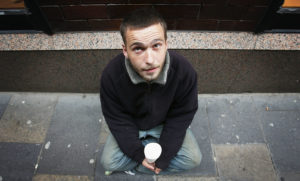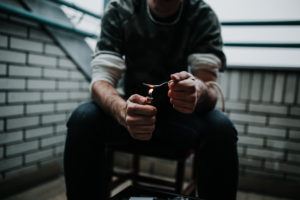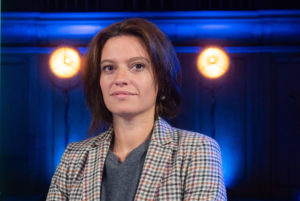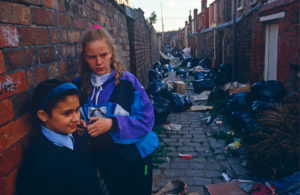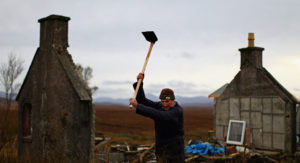Lindsay lives in a council house in Kirkwall, the largest town in Orkney, a starkly beautiful archipelago off the north coast of Scotland. Now in her mid-fifties, Lindsay has lived in her one-bedroom house for 17 years. She’s tended the garden, hung her pictures on the walls. But she has no great love for the place. It’s cold and damp. Very cold. Very damp. Cold enough that she can’t sleep. Damp enough that the clothes in her wardrobe turn green with mould. And it seems like nothing she does ever helps.
There are radiators. They work, and she puts them on. But the house doesn’t seem to get any warmer. This winter, she says, the temperature inside her house hovered between 10 and 12°C — well below the recommended domestic temperature range of 18 to 21°C. Every minute, as those heaters exude their vanishing warmth, the bills are ticking up, up, up. Currently, she says, it costs her between £10 and £15 a day to heat the little house — or to not heat it, which is what it really feels like she’s doing.
Lindsay suffers from chronic pain, one symptom of the fibromyalgia that impacts her ability to work, and the cold exacerbates her condition. Recently, she told me, it’s all become too much. She’s in crisis. Watching her money run out as she sleeps under a duvet that seems wet to the touch — it feels like more than anyone should have to cope with. She’s not sure that she can anymore.
When money is tight, all winters are bad winters. But at the turn of 2022-23, after energy costs soared, more Britons than ever have been facing hard choices and cold beds as they struggle to get by while wages stagnate and prices soar. From October 2021 to October 2022, domestic gas prices increased by 129% and electricity by 66%, according to data from the UK government; the average annual energy bill has increased almost 96% over the same period, to £2,500.
With some fanfare, Liz Truss’s short-lived regime offered a “guarantee” that the energy price cap would not rise any further for households for at least another two years. Rishi Sunak’s administration soon rowed back on that — although the Budget earlier this month did extend the energy price cap for three more months, until June. As for the new SNP leader Humza Yousaf, who is now staring at a £1.5 billion black hole in the national budget according to the Scottish Fiscal Commission, fuel poverty in Scotland’s coldest rural regions presents a significant financial challenge. All this uncertainty has left Lindsay, and those who have suffered similarly difficult winters, with little idea about what help they will or won’t be entitled to in the future.
Those living in rural Scotland are under singularly intense pressure. Because the price cap and associated guarantees apply to unit cost, not the total bill, bills will often end up more than £2,500 in households requiring higher consumption to maintain a decent temperature. And for any homes where the main energy source is anything other mains gas or electricity, nothing is capped or guaranteed. Nearly 90% of homes in Na h-Eileanan Siar (also known as the Outer Hebrides) and 100% of homes in Orkney and Shetland are not connected to the mains gas grid, forcing residents to use more expensive and uncapped options such as bottled gas or domestic heating oil.
In Autumn 2022, Energy Action Scotland published an analysis that showed residents of some Scottish council areas — Na h-Eileanan Siar, Shetland, and Argyll and Bute — have seen bills rise to more than £4,000 a year. A huge outgoing when you consider that the median Scottish household income is £27,716. Partly these higher bills are a function of the harsher climate — those raging gales that blow in off the sea, battering the rooftops and bringing a bitter windchill for days at a time. But partly, too, it is linked to a poorer standard of housing; rural houses are less likely to be well insulated.
Lindsay’s experience underlines what the statistics tell us: cold homes are associated with both mental and physical illness. Long-term exposure to the cold increases the risk of respiratory and circulatory illnesses, as well as exacerbating the symptoms of chronic conditions such as arthritis, diabetes and chronic obstructive pulmonary disease. Issues of damp and mould, common in poorly insulated and cold homes, are associated with asthma and respiratory infections, especially in children. The death of two-year-old Awaab Ishak due to breathing difficulties in a mouldy Rochdale flat, which inspired much soul-searching in England after the 2022 coroner’s inquest, occurred on the winter solstice in 2020.
“Physiologically,” Dr Raquel Nunes, an assistant professor of public health at Warwick University, told me, “the body will try to compensate for the cold. What happens is that the blood becomes thicker, and that can cause clots.” The clots can then cause heart attacks or strokes. “Cold also affects the ability of the body to fight infection. That increases the probability of common colds, flu, and other diseases.”
Unheated houses also have insidious effects on mental health. The fear of being unable to keep your family warm is a major source of anxiety. Those in fuel poverty often limit socialising — either because they stop inviting people to their homes, or simply go to bed early to keep warm under the blankets.
This rings true to Miranda, a woman in her early thirties who lives with a dog and a cat in a row of old farm workers cottages near the Dornoch Firth, in the northeast Highlands. She lives with complex health problems and as a result has been “medically retired” for some time and must rely on disability benefits. This has left her in dire financial straits. Hers is an old stone cottage, “only a small two-bedroom”, but though well-built it’s not good for retaining warmth. “It costs £15 a day to heat. I can’t afford that.” The cold, and the aches and anxiety that come with it, is “definitely having an effect on my head,” she says. Her depression, she says, is “horrific”. She just cannot see how she’s going to get through the next year.
As winter set in last year, new research confirmed that when people’s homes become cold, the danger of severe mental distress significantly increases. Data from the UK Household Longitudinal Study reveals that the risk doubles among those who have not previously suffered mental health problems; it triples for those who have previously suffered even minor symptoms. Those with underlying psychiatric disorders are also more likely to die or be admitted to hospital during periods of extreme cold.
Miranda’s problems are, unfortunately, increasingly common. Research by the Joseph Rowntree Foundation found that nearly a third of low-income households — more than 3 million of them — were already unable to adequately heat their homes in early 2022, before the impact of the energy price crisis were fully felt.
If the problems are distinctly intense in the Highlands and Islands of Scotland, its people are also turning to one distinctive solution. Recent reports point to residents in the Western Isles, Caithness and Orkney reverting to traditional methods, cutting and drying more peat to use as fuel over winter; neat stacks of drying peat bricks line up along the road-sides all through Lewis and Harris. In January 2023, Press and Journal, the newspaper of the Highlands, carried an interview with Uist crofter Anne MacLellan, who had “got peat on the fire just now” as she talked, despite having “never heated her home with peat” in the past. She felt a “massive conflict” in light of the grim environmental consequences of disturbing and burning this carbon sink. But the quarter of Anne’s wage that was disappearing in energy bills each month was simply too much to bear.
Those in urban areas have different tactics — spending more time on public transport and other public spaces where they are not on the hook for keeping warm. All over the country, churches and community centres have opted to open their doors to those in need of a warm place to go. The Warm Welcome campaign maintains online listings of “warm banks” across the UK. There are more than 4,000 such hubs now open to the public — including synagogues, Salvation Army halls, pubs, and arts centres — their proliferation attesting not only to a remarkable generosity of spirit across civil society, but also to the extent of the crisis we now face.
Even those in full-time work are not exempt. Liam is a joiner and part-time gamekeeper who lives with his partner Rochelle and her teenage daughter in Dingwall, a market town around 30 minutes’ drive from Inverness. After finally managing to get together a deposit after years of saving, they bought a house — which when we spoke they were on the cusp of moving into — just as the cost-of-living crisis came to bite.
He gets a good wage, he says. And Rochelle works too, in an outdoors shop, albeit on a zero-hours contract. But even so — he runs the figures in his head as we talk — almost a quarter of his salary goes on energy, which works out at around £350 a month. Until recently, in their rented house, they were able to avoid turning the heating by burning offcuts he brought home from work in a wood-burning stove. In the new house they won’t have that option: “We’ll grudge pushing that button.”
They feel fortunate, relatively speaking. But the couple are not immune from the pressures. It’s visible all around them, etched into the faces of their Highland neighbours. “There’s no spirit,” Liam says, “everything has gone. It’s bleak. Very bleak. No one wants to enjoy themselves — there’s no going down the pub for a couple of pints, or having drinks with the girls. People think: that’s three days’ heating.”
He and Rochelle are made of stoic stuff. They’ve been through hell and back, he says — both are previously divorced, and lost family members in upsetting circumstances. Money worries are nothing new. They talk about it, figure out a plan. Such is the picture in homes across the UK: couples sitting down to crisis talks; single parents checking their balance, turning down the heat. The black dog at the door. For many people, it is all too much to bear.
***
This piece was from a longer essay in Broke: Fixing Britain’s poverty crisis (Biteback Publishing), edited by Tom Clark. Additional reporting by Laura Beveridge.
Disclaimer
Some of the posts we share are controversial and we do not necessarily agree with them in the whole extend. Sometimes we agree with the content or part of it but we do not agree with the narration or language. Nevertheless we find them somehow interesting, valuable and/or informative or we share them, because we strongly believe in freedom of speech, free press and journalism. We strongly encourage you to have a critical approach to all the content, do your own research and analysis to build your own opinion.
We would be glad to have your feedback.
Source: UnHerd Read the original article here: https://unherd.com/

